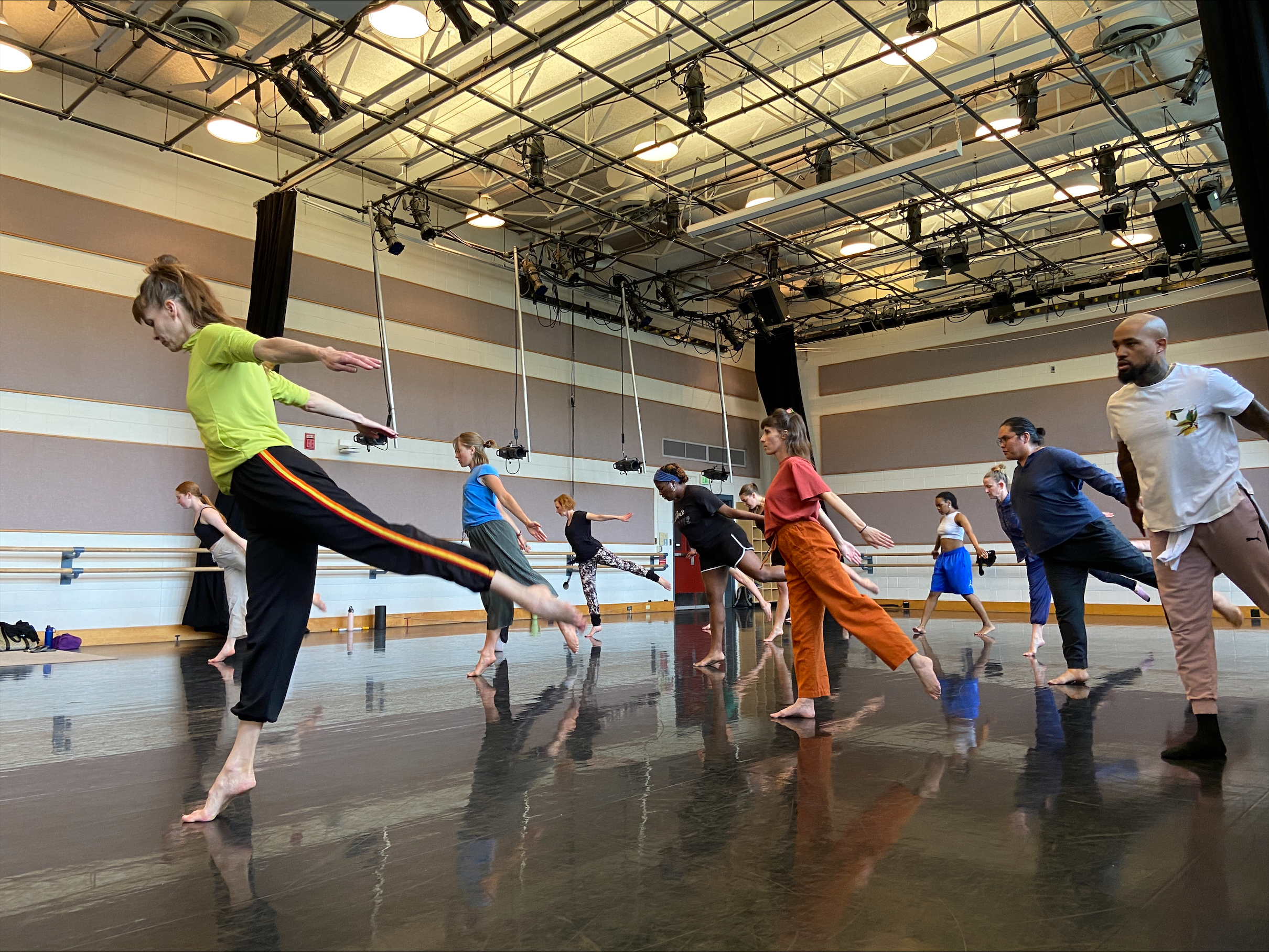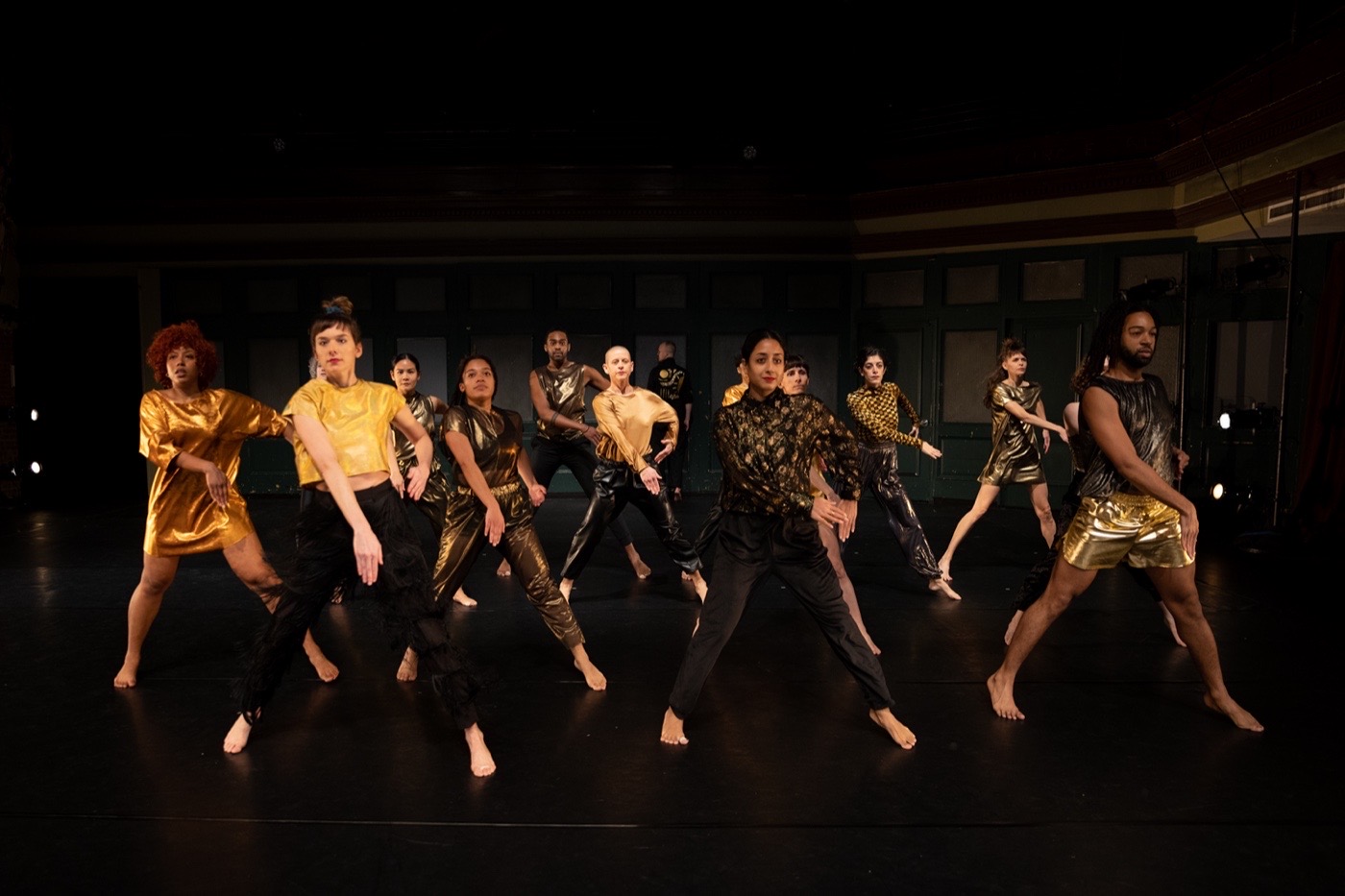“It’s funny… I’ve never gotten a blister on my foot until this performance,” said University of Utah Dance student Kiya Green.
Green was referring to BIG BEATS, which she performed last year alongside other U Dance students and faculty as part of the U’s collaboration with Brooklyn-based choreographer Joanna Kotze. Now, nine months later, Green and many of the other dancers will reunite to perform the piece from which BIG BEATS was drawn: ‘lectric Eye.
‘lectric Eye is a dynamic work by Joanna Kotze. Presented by the U’s School of Dance and Utah Presents, ‘lectric Eye explores the human body’s potential for persistence, resistance, and power. U faculty and students will dance alongside Kotze, the key ‘lectric Eye performers, and other freelance dancers in this exciting work that features music from composer/musician Ryan Seaton and lighting design by Kathy Kaufman.
Hosting ‘lectric Eye on campus provided a unique chance for faculty and students to dance alongside each other as professionals, to feel that exhaustion and triumph together as peers. And it’s been a way to once again build a new community. “Being able to do both BIG BEATS and ‘lectric Eye with this community is very special,” Kotze said. “I feel the excitement and the commitment from everybody who is involved. There’s really such a generosity amongst the dancers.”
“It's going to kind of like be like riding a bike,” Green said of heading into rehearsals for ‘lectric Eye. But she’s most excited to be reunited with her fellow cast members and work with them again.
The bond between the dancers reflects one of the key elements Kotze built into the piece: community.
U Dance student Lily Hammons (who will be graduating this week), says this kind of dance was different than anything she’s done before. “A lot of the things I’ve been working on lately have been less choreographically driven and more abstract, more improv-based,” she said. “So this choreography is very different as it was already set… and I haven’t ever done that. That was kind of challenging for me to be able to fit into it.”
Green says her experience with the choreography has been similar. “When I dance, personally, I let my mind go and my body does whatever,” she said. “Having to constantly be engaged and being aware of what’s happening — in a 360! — is really interesting… It’s a group dance, but everybody has their individual responsibilities. It keeps me very engaged.”
The movement doesn’t aim for the dancers to become lost in the group. Rather, it heightens both the dancers’ and the audience’s perception of individuality. “The thing that’s been interesting to me is how we see [the] individual within the collective unison,” Kotze said. While all the dancers are performing the same movements, their differences and quirks and intricacies can be more apparent, and the dancers have worked through that process in their rehearsals," said Kotze. “We work to arrive there together in each person's own way of learning and also their own architecture of their own body.”

Additionally, it’s imperative that the dancers actively work together. “Each person has to be very attuned to what’s happening,” Kotze described. “Because if somebody messes up, if somebody goes in the wrong direction… you have to be right there with everybody else to get that person back on track.”
The energy and focus required to complete this section of ‘lectric Eye makes it feel like a marathon feat. For Hammons, that sense of accomplishment has built community for her. “With people of such wide varieties of backgrounds, [it] has been really rewarding for me to be able to see how we can all just come together and learn this really complex movement and be completely exhausted, but also exhilarated at the same time,” she said.
This kind of large group unison is not Kotze’s typical style and came about largely due to the environment of ‘lectric Eye’s creation. Kotze began choreographing the ‘lectric Eye in 2018, working with composer/musician Ryan Seaton as well as with dancer (and U Dance Professor) Molly Heller. Eventually adding in dancers Wendell Gray II and Symara Sarai to the core group, Kotze realized she wanted more people performing these movements together. “It was the middle of COVID,” she said, “and we all really wanted to be with other people… it was something that I couldn’t get out of my mind… because of where we were in history.”
“Being able to do both BIG BEATS and ‘lectric Eye with this community is very special.”
- Joanna Kotze
As the piece transitions out of the group piece and into the first of its four solos, that history is again reflected to the audience. The music for the piece is performed onstage by Ryan Seaton, who sings “How do we continue?” As the energy of the group leaves the stage, and a solo performer is left isolated, that question feels even more poignant.
The first solo is performed by Kotze. Lit by a spotlight, the space of the stage seemingly shrinks. After the explosiveness of the first section, Kotze uses her solo to draw attention to the labor of slow tension. “There’s this effort of constantly moving in the first section,” she said. “So when I was developing this solo, I was challenging myself to use time in a different way. How long does it take for my body to [stretch]?”
Pushing the body to its limit also comes up in Professor Molly Heller’s solo, which is at the end of ‘lectric Eye. “[The] art of my solos is very much for me about the repetition and the vulnerability of doing something over and over again, and what emerges from those tasks,” Heller said. “Every single time I do the solo I literally think to myself, 'I don’t know if I can do this.'” Due to how demanding the solo is — not to mention the first section of the piece — Heller’s performance communicates the need for persistence and living in the moment. “There’s something about [the solo] that requires me to be really, really, really present. Like, I don’t know if I can get through this, but what if I just focus on this one movement right now… there’s a rawness and humanness I think that people can relate to.”
It’s part of Kotze’s aim with ‘lectric Eye to show how demanding the movement can be. “A lot of my work exposes effort and labor in the body in a way that, say, ballet doesn’t,” she said. “It’s not about creating the effort on top of something, but what is the actual movement and how does effort and labor emerge from doing that movement.” And this isn’t just about the physical feat of the performance, she said, adding, “I think I’m drawn to that because life is effortful… life is challenging.”
This is where the thematic elements of the piece come together — where community, solitude, labor, and persistence meet. “The piece has been created during a particular political and social time in this country,” Kotze said. “That has definitely played a role in terms of how to we persist, how do we resist, and how do we continue to find power within ourselves and as a collective.”
In this way, the piece communicates a powerful realization. “There’s a kind of empowerment of knowing you can get through something and you can still keep doing it given what shows up in the moment,” Heller said.
Hammons agrees, adding that she finds support in the dancers around her. “I am always exhausted by the end. It’s nice to feel exhausted and to know that everyone around you knows that you’re exhausted but you’re still going.” For Kotze, that’s a very joyous element of the piece: “You come out the other end thinking, 'wow, we did this, and we did this together.'”
See ‘lectric Eye May 9-11 at 7:30 pm in the Marriott Center for Dance. Purchase tickets here.

